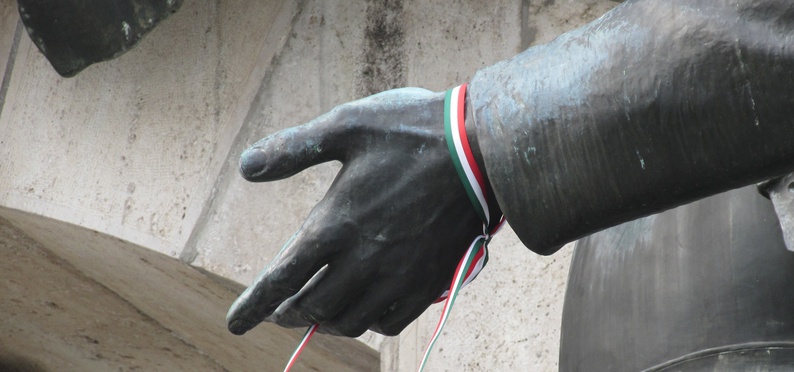
A Border Disorder
Published on
The European nomad crisis implicitly makes us reconsider the concept of state borders.
The situation around migrants besetting the EU southeastern borderlands can become very soon a game-changer for the European demography, economy, and security. Amidst that crisis, developments at the borders are the focus of public interest. However, in the long-time perspective, what is happening to the borders themselves could be of a greater concern.
Our idea of the boundary evolved along with the acceleration of globalization and regional integration: the discourse embraced Ohmae’s ‘borderless world’ and Castellsian ‘space of flows’; ‘alternative’ kinds of boundaries, ethnical and cultural among them, caught the attention of scholars and practitioners. A case in point was Hungary’s ‘re-bordering’ rhetoric of being finally able to take under Turul’s wing ethnic Hungarians and Szekelys from limitrophe countries within the ‘borderless’ EU. However, drawing contours of inclusion for all non-alien elements was only one of the borderwork paths explored by Hungary.
 Disillusioned, in the recent months the country rolled back to plain political geography: with the advent of the migrants traditional barrier and filter functions of the border came to the forefront. Initially, the Hungarian PM faced a purely logistical issue of migrant flows management. The country needed an efficiently operating system so as to guarantee transfrontier safety and security, while duly processing every potential asylum-seeker. Under rising external pressure, the Hungarian authorities recurred to barrages and barbed wire, reckoning indeed, that “strong fences and walls do create <…> a manageable situation”, as David Newman put it.
Disillusioned, in the recent months the country rolled back to plain political geography: with the advent of the migrants traditional barrier and filter functions of the border came to the forefront. Initially, the Hungarian PM faced a purely logistical issue of migrant flows management. The country needed an efficiently operating system so as to guarantee transfrontier safety and security, while duly processing every potential asylum-seeker. Under rising external pressure, the Hungarian authorities recurred to barrages and barbed wire, reckoning indeed, that “strong fences and walls do create <…> a manageable situation”, as David Newman put it.
That occurrence is a graver symptom than it might seem. Whether physical barriers are relatively easy to surpass or not, what makes them truly reliable is shared recognition of several conventional facts regarding institutes of national sovereignty, border regime, and everyday practices of border-crossing. In that multidimensional complex rules, in particular those stipulating migratory and border regime, are to lean upon, and wire is an optional element. Its role is primarily symbolic, for hardly would authorities want to augment misery with more injuries. On the other hand, it is effective enough to remind of legal order in turbulent times. Hungary was reduced to restoring spatial discipline using this powerful material instrument, once the law stopped being self-enforcing.
Such logic found little understanding at the EU level with Tusk’s questioning its humanity. His argument hardly can be accepted in Hungary. The state officials do not see the current crisis as a humanitarian matter, at least for the incomers, for it is from technically safe countries that they flee to Hungary. Yet, in trespassing its metes and bounds the migrants scrape this geopolitical amputee’s scars. Within the country no one, it seems, intends to forget the lawful ‘injustice’ of Trianon, including the impact on people’s lives the penalty for waging aggressive war had. So contending of the regime of Hungary’s borders left rather appears to be a matter of massive voluntarism.
 Regressing deeper into history, Hungarians possess quite an expertise in the matter of unharnessed hordes. Through the Hunnic invasion and the Ottoman conquest Hungary earned its archetypical (self-)perception of Europe's last bastion. Today it may be a centuries-old gut feeling nagging the decision-makers that failures to protect the border spell another disaster for the homeland. Let us add to that the immense symbolic burden any state boundary mark is endowed with, as far as the former stems from the universal value of state sovereignty. Then it becomes clear, that the migrants’ “breaking the door” threatens both, national security and sovereignty of Hungary, which explains Orban’s being desperately adamant and seeking the EU and UN support in removing the ‘root causes’ of the crisis.
Regressing deeper into history, Hungarians possess quite an expertise in the matter of unharnessed hordes. Through the Hunnic invasion and the Ottoman conquest Hungary earned its archetypical (self-)perception of Europe's last bastion. Today it may be a centuries-old gut feeling nagging the decision-makers that failures to protect the border spell another disaster for the homeland. Let us add to that the immense symbolic burden any state boundary mark is endowed with, as far as the former stems from the universal value of state sovereignty. Then it becomes clear, that the migrants’ “breaking the door” threatens both, national security and sovereignty of Hungary, which explains Orban’s being desperately adamant and seeking the EU and UN support in removing the ‘root causes’ of the crisis.
Conversely, at the 70th session of the UN General Assembly critics of Orban who insists on space discretion remain in the ‘free-flow’ paradigm. First, such approach is inconsistent with the national security understanding and practices prevalent since the terrorist attacks at the turn of the millennium. Second, it painfully resounds the storyline in the Game of Thrones series. Last summer the TV audience was offered suggestively luscious humanity of the antagonistic wildlings as the reason to accept the wall gate opening for them to pass in. More importantly for the plot and speculations, they had a greater evil to fight together with the Night Watch.
The ‘no-walls’ urge from the UN rostrum by the American President looks especially dull in the light of la frontera, a most notorious border between the U.S. and Mexico. Hundreds of non-American citizens perish each year in their attempt to cross illegally from the Mexican side, hundreds of thousands are arrested, but most cross safely. Thus, Obama knows how expensive it is to build border walls, how helpless a democratic state can feel when costly barriers prove dysfunctional. With his unprecedented and controversial presidential executive action on immigration he resorted to the last thing a leader could do, he granted a sui generis ‘recognition’ de jure for almost 4 million illegal migrants (approximately 3 million Mexicans among them) through introducing legalization alleviation. Still, the southern border, allegedly, remains a priority for order enforcement. The political step was announced the same year the U.S. FDI in Mexican economy dropped to the lowest level in 15 years. Even less encouraging prospects for many Mexicans open with the Trans-Pacific Partnership project favoured by Obama against the withering NAFTA. The U.S. appears unable to lead by example in border management.
Back to Europe, we should keep in mind that a refugee status is not a question of self-determination nor media labeling. It is a legal status granted by a competent authority after an examination of each individual case, and it is quite probable that many of the migrants do not fall under the definition found in the 1951 Geneva Convention. All the assistance and benefits asylum-seeker may count for are contingent primarily not on the good will and kindness of European citizens, rather on the provision of national legislations and the observance of respective procedures. The appropriateness of an ‘overly-humanistic turn’ is highly questionable, since generally legal norms are already bound to approximate justice. Significantly, without executive control they cannot secure any justice.
Letting all the migrants pass ‘in bulk’ in conceding to the populist hail would bring a major change into the practice of transboundary flow management. New practices will morph as well the ideational component of the border, and then - if we adopt a Wendtian angle – these new shared understandings will determine future institutional developments and physical transformations of regional and global spatial environments. The institute of border is now in a liminal phase itself. What is at stake in the international debate on the migrant crisis is the power lying exactly in the possibility to control intersubjective understandings and, later, practices that will take place after the closure of the crisis.
The European entanglement is fraught with the risks that external actors will have an upper hand in a state’s border management and that sovereign border governance is rendered negotiable. The European Union that once conceived the Schengen space aiming to eliminate interior interstate barriers and to secure the peripheral confines, has now partially lost faith in subsidiary decisions and is on the verge of consciously weakening its exterior member-state borders. The perilous aspect is that state borders are instrumentally expressed through separation, but essentially are about possession. Cutting ‘bleed-throughs’, to use Anzaldua’s metaphor, dramatically affects what is contained inside. Some countries find literally constructive ways to preserve the state machinery, premising that one has to erect walls to build corridors.



